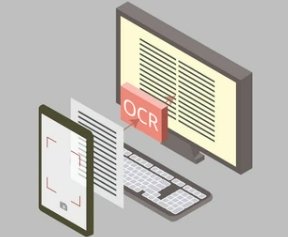What is OCR ?
In today’s digital age, there is a vast amount of information to process, store, and retrieve. With the exponential increase in digital data, the need for efficient and accurate data entry and retrieval methods has become paramount. Optical Character Recognition (OCR) is one of the most significant advancements in the field of data entry and inspection. In this article, we explore OCR, its working mechanism, and its applications.

What is OCR?
OCR (Optical Character Recognition) is a technology that recognizes text within images and scanned documents and converts it into machine-readable text. This enables computers to read human-written or printed text, making it easier to digitize, store, and retrieve information.
OCR technology has been around for over 50 years and has come a long way since its inception. It was initially used to recognize typed text and was limited in its accuracy. However, with the advancement of technology, OCR has become more sophisticated and more accurate, making it possible to recognize cursive handwriting, different fonts, and even complex mathematical equations.
OCR not only plays an essential role in digitization and paperless transformation, but it can also be combined with AI for applications such as defect detection, license plate recognition, automatic inspection, and identification verification.
Different Types of OCR
OCR technology is divided into the following categories:
Simple OCR Software
Simple OCR software uses pattern matching to compare the received text with samples from a database of different text and font patterns.
ICR for Enhanced OCR
ICR (Intelligent Character Recognition) is an advanced form of OCR that recognizes handwritten text. However, this technology has limitations and is better suited for recognizing structured handwriting, such as evenly spaced characters on lined paper or in a box.
IWR for Enhanced ICR
IWR (Intelligent Word Recognition) is an extension of ICR that can recognize words, phrases, and even sentences. For example, while ICR can recognize ‘C’, ‘A’, and ‘T’ as individual letters, IWR would recognize the whole word ‘CAT’. IWR is capable of automatically correcting spelling errors by matching with a database of words and considering the structure of the entire sentence.
How Does OCR Work?
OCR technology works by analyzing the patterns of light and dark in an image or document to recognize individual characters. The working process of OCR can be divided into three stages:
The first stage of OCR is pre-processing, which involves preparing the image or document for scanning. During this stage, the image or document is cleaned to remove any noise or unwanted marks. The pre-processing stage also involves deskewing, which corrects the orientation of the text and removes any distortions caused by the scanning process, and thinning, which is the thinning of the lines of characters leaving only a clear skeleton structure of the entire text to eliminate the fuzzy area that may cause recognition errors at the edges of the text. These steps are important because the higher and clearer the resolution of the image input is, the better it is for OCR, resulting in more accurate recognition.
The second stage of OCR is text recognition. The algorithm performs text recognition through a process called feature extraction—breaking down the text into small features, such as lines and intersection points, and comparing them to find the most similar characters. The text is then compared with the pre-established text database to see which is the closest match—this is known as pattern comparison.
During the final stage, the OCR algorithm verifies the accuracy of the recognized text and corrects any errors. The post-processing stage involves tasks such as spell-checking, word recognition, and character segmentation. After the analysis, the OCR system converts the recognized text data into a digital file.
Applications of OCR
OCR technology has numerous applications. Here are a few examples:
Document Digitization
OCR technology is widely used to digitize paper-based documents such as books, journals, and newspapers. OCR software extracts text from these documents and converts them into machine-readable formats such as Word or PDF.
Data Entry
OCR technology is used to automate data entry tasks such as invoice processing, form filling, and ID card recognition. OCR software can read information from documents and enter it directly into databases, reducing the time and effort required for manual data entry.
Image and Video Analysis
OCR technology is used in image and video analysis applications such as surveillance and security. OCR software can recognize license plates, faces, and other objects in images and videos, making it easier to track and identify them.
Accessibility
OCR technology is used to make printed materials accessible to visually impaired people. OCR software can convert printed materials into Braille or synthetic speech, making it easier for visually impaired people to read and access information.
Use of OCR by Industry
Here are some examples of how OCR technology is being leveraged in some key industries:

Manufacturing
In Industry 4.0, many factories are moving towards smart manufacturing, and the digitization of data and electronic workflows is seen as an important and indispensable part of smart manufacturing. Through data digitization, a complete production history can be created and stored step-by-step in a central database, which can be used for real-time tracking and data accumulation. In the era of data dominance, this is a valuable asset for enterprises, making it easier to optimize production lines.

Food & Beverage
Governments worldwide have imposed stricter requirements for information displayed on food packaging. Failure to comply, such as printing errors or incorrect expiration dates, can result in significant fines for manufacturers. By utilizing OCR technology to identify mistakes on labels and packaging, manufacturers can minimize the possibility of distributing products with incorrect information to customers.

Healthcare
In healthcare, every second counts, and frontline workers may have to deal with hundreds of patients every day. Handling handwritten medical records or reports can make frontline personnel overwhelmed. OCR technology can quickly convert paper-based data into digital documents and import them into the hospital or clinic’s backend system. Even small printed characters on drug bottles or packaging can be detected and recognized through OCR and imported into the database, immediately matching the patient and establishing a complete record for the medical institution.

Logistics
When it comes to logistics, barcodes, addresses, and other text on packages are necessary for distribution and delivery. However, relying on manual sorting and data entry can lead to errors and slower processing and delivery times. OCR technology can be integrated with automated devices, such as robotic arms, to significantly enhance distribution efficiency. By automating the process of package tracking, OCR technology can help ensure accurate and timely delivery while reducing the risk of errors and delays.
Benefits of OCR
OCR technology has numerous benefits, which include the following:
Time-saving
OCR technology can automate tedious and time-consuming tasks such as data entry and document retrieval, allowing workers to focus on more critical or high-impact tasks.
Cost-effective
OCR technology offers a solution to reduce labor costs associated with manual data entry. By automating the process, organizations can eliminate the need for manual data entry, saving time and money. OCR technology can also help reduce the cost of storing and retrieving paper-based documents by converting them into digital files, which can be easily stored, organized, and accessed.
Increased Accuracy
OCR technology has a high degree of accuracy, and the error rate is lower than that of manual data entry.
Greater Accessibility
OCR technology can improve accessibility within organizations by converting printed or handwritten documents into digital text that can be easily accessed and archived. This is particularly beneficial in hybrid or off-site work settings, or in organizations where collaborative document sharing is required.
Challenges with OCR
Some of the key challenges associated with OCR include:
Complex Formatting
OCR technology can struggle with complex formatting, such as tables, graphs, and charts. OCR software may not be able to recognize the structure of these elements, leading to errors in data extraction.
Handwriting Recognition
While OCR technology has improved significantly in recognizing handwriting, it still struggles with highly stylized and illegible handwriting.
Poor Quality Documents
OCR technology requires high-quality images and documents for accurate recognition. Obscured text or damaged documents, such as those with stains, creases, or faded text, may not be recognized accurately.
Language and Font Recognition
Some OCR programs may not recognize certain languages and fonts accurately. OCR software may struggle with recognizing non-Latin scripts, handwriting, and complex fonts.
Summary
OCR technology has made it possible to convert printed or handwritten text into digital text that can be easily edited, searched, and analyzed—making data entry and retrieval faster, more accurate, and cost-effective. OCR technology is widely used in a range of industries, from manufacturing to logistics, and has proven to be particularly useful in machine vision applications. While OCR technology faces challenges with handwriting recognition, poor image quality, and font recognition, continued development and refinement of the technology will help to overcome these issues. As data accumulation continues to grow, OCR will play an increasingly important role in improving productivity, efficiency, and accuracy across multiple industries.
OCR FAQs
Is OCR accurate?
OCR technology has a high degree of accuracy, and the error rate is lower than that of manual data entry. However, some OCR programs may struggle with recognizing complex formatting, certain styles of handwriting, damaged documents, and obscured text.
What is the difference between OCR and OMR?
OCR recognizes text within images and scanned documents, while OMR (Optical Mark Recognition) recognizes marked data such as checkboxes and multiple-choice responses.
Can OCR recognize handwriting?
OCR technology has improved significantly in recognizing handwriting, but it may still struggle with highly stylized and illegible handwriting.
Can OCR recognize different languages?
OCR technology may not recognize certain languages accurately, and it may struggle with non-Latin scripts, complex fonts, and some handwriting styles.

